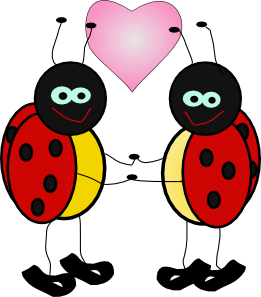
The popular perception of ladybugs. Clipart by Marketa Bauerova.
I was studying outside the other day when I began to notice a couple of small, alligator-like insects circling the outer rim of my table. Curious about these little creatures, I let one crawl onto my hand. It looped around my fingers for a while with surprising speed until I placed it back down and it continued its little circuit around my table.
Using the internet’s infinite wisdom (this website in particular), I was able to identify the insect as a ladybug* larva. In particular, it was an Asian Multicolored Lady Beetle, or Harmonia axyridis. The first things that I discovered about my new friend is that it emits a pungent odor and sometimes bites. I looked down again at the bumpy insect squirming around my table with a newfound sense of disgust, hoping it hadn’t left it’s odorous mark on me.
And that was just strike one for this ladybug.
I was talking to a friend a little while later when our conversation was cut short by the sudden appearance of a larvae falling out of my hair. My voluminous hair has been known to consume anything from bubble gum to bobby pins, but this was certainly a first. Even later, I found one squished in between the pages of a textbook. I knew that I was either very unsanitary, as my friend now suspected, or that they were so common that all of these interactions were not improbable. In any case, I knew that there would be some interesting science behind my insect encounters.
An Asian multicolored lady beetle larva found by the fountains near Brochstein Pavilion (on Rice University Campus). Photo by Marie Hoeger.
Asian Multicolored Lady Beetles in North America
It turns out that the Asian Multicolored Lady Beetle is an introduced invasive species that is causing some trouble in North American and European countries. They have been released multiple times in North America as biological control agents (they’re very effective aphid predators) from as early as 1916. They failed to establish in North America until 1988, when their populations started exploding. Now, they are expanding at an extremely rapid rate — approximately 442 km per year (read a chapter from this book to learn more about the impact and history of Asian Multicolored Lady Beetles in North America).
These lady beetles have been shown to be highly successful in controlling aphid pest species, as intended. An adult eats roughly 60 aphids per day, and even smaller larvae eat around 25 aphids per day. However, the benefits to humans only last through summer and spring. Around fall, they migrate in masses and become a common pest. They flock to houses and other man-made structure as winter approaches to hibernate in cracks and crevices. Their massive aggregations stain carpets, curtains, furniture, and more.
Because they’re such highly generalized and effective predators, they’re also harmful to many native and non-target species. On top of depleting the food source, they actually eat the eggs of their native brethren (this type of predation is called intraguild predation — it’s literally a ladybug eat ladybug world they live in). Although native species’ larvae also prey on Asian lady beetle eggs (not so cute, eh?), according to this Journal of Insect Science article, the Asian lady beetle is just better at it. Overall, they’ve made a positive impact in some areas of pest control, but are largely considered a model of the dangers and failure of introducing new species as biological controls.

An Asian multicolored lady beetle larva eating native lady beetle larva. Photo by Don J. Dinndorf, blogger on whatsthatbug.com.
The Sex and the Cannibalism
Through my research of the Asian Multicolored Lady Beetle, my conception of ladybugs as these adorable, charismatic creatures has certainly changed. But those are just the Asian Multicolored Lady Beetles right? Nope, ladybugs are just really weird, kind of disgusting and fascinating creatures. Here’s the evidence:
- When threatened, ladybugs begin to bleed from their knees. Their blood is full of toxic chemicals that make them taste bad to predators, so bleeding a little gives them a preview of the meal to come (learn more about ladybugs here).
- Ladybugs have the most sexually transmitted infections of virtually any insect. In the words of Dr. Greg Hurst of the University of College London, ladybugs are “remarkably promiscuous.”
- Ladybugs are cannibals, especially when food sources are scarce. They feed on both sibling and non-sibling eggs.

Two ladybugs eating a dead ladybug. Photo by Maria F., WordPress blogger. You can read her story about this image by clicking the image.
*DISCLAIMER: The term “ladybug,” is actually a misnomer. Ladybugs are small beetles of the Coccinellidae family, and not true bugs (true bugs belong to the insect order Hemiptera). I often refer to these lady beetles as ladybugs because that is how they are colloquially known.
